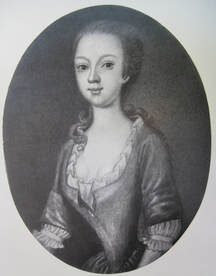SUSAN (SUSANNAH) TRAIL (1720-

Susan Trail played an important role in the history of printing in Aberdeen though she was virtually invisible. Born in Montrose in 1720, her parents were Christian Allardyce, daughter of John Allardes (Allardyce), three times provost of Aberdeen, and Rev. James Trail, minister of Montrose. In about 1740 she married James Chalmers, ten years her senior and son of the Professor of Divinity, Printer to the Town and Marischal College. Aberdeen had a history of appointing women as printers ot the town, largely as inheritors of husbands’ businesses. A succession of female printers, their daughters, husbands, and sons were appointed ‘Printer to the Town’ in Aberdeen. In 1705, Margaret Cuthbert succeeded her husband; later their daughter, Margaret Forbes, and her husband James Nicoll, a Merchant Burgess, were admitted to the position in place of her mother, who had also died.
Although she bore eight children (and buried four), evidence suggests she worked in the printing business, including the new Aberdeen Journal, begun in 1746, initially as a report on the Battle of Culloden. During the retreat from Culloden, James a staunch Hanoverian had to escape from the rebels with his life to Old Aberdeen where he went into hiding. It is not reported what happened to Susan when their house and printing office were ransacked, although she had a toddler in hand, had just given birth to a son who died and was very likey pregnant with her third son.
When James died in 1764, she took over the business and newspaper. Trail had worked alongside her husband, printer to the town, and on his death, she petitioned the Council to retain this position on her own behalf as well as her son’s claiming he intended to ‘carry on the Printing business along with their Petitioner [Susan]’. The council in return ‘unanimously Granted the desire of the same [Susan] … and the longest liver of them to be Town’s Printers’ retaining all the profits and emoluments. This represented a vote of confidence in her abilities. Significantly, her petition and the Council response underlined the joint operation, in which she was clearly identified as an equal partner, and she would hold all rights if she survived her son. This represents a vote of confidence in her abilities. As James was still in London, she continued managing the printing activities for over a year on her own. In October, The Aberdeen Journal, published by Traill and Chalmers, emphasised the joint operation, advertising that Chalmers intended to continue printing in all its forms ‘in Conjunction with his Mother’ and that they were to stand as candidates for the position of Printers to the County.
Although father and son were the public faces of the business, she was clearly involved in the management for some years during both their tenures, alluding to it in her petition. No histories of the paper or printing in Aberdeen however, note this. She had clearly worked in partnership with her husband, and her position and rights were recognized in the council’s enactment. At the least, her son was trading on that fact; at best he would rely on her as an active partner. Patronage played an important role in the corporate community, and positions were obtained through an informal but powerful network of clientele, connection and recommendation. She also refers to family and connections in her petition underlining the importance of connections in running business, and one seen as ‘male’ in a town like Aberdeen. These appointments clearly represented publicly recognised standing, having been granted by an elite group of men, who ran their cities from a position of wealth, power and prestige. Nevertheless, such appointments may say more about the operation of patronage, the ‘public relations’ skills of the women and their family connections than about technical skills as printers pulling the press.
A copy of the petition is in, Deborah Simonton, Women in European Culture and Society, A Sourcebook. Routledge, 2013, 62-4
Entry written by Deborah Simonton
Although she bore eight children (and buried four), evidence suggests she worked in the printing business, including the new Aberdeen Journal, begun in 1746, initially as a report on the Battle of Culloden. During the retreat from Culloden, James a staunch Hanoverian had to escape from the rebels with his life to Old Aberdeen where he went into hiding. It is not reported what happened to Susan when their house and printing office were ransacked, although she had a toddler in hand, had just given birth to a son who died and was very likey pregnant with her third son.
When James died in 1764, she took over the business and newspaper. Trail had worked alongside her husband, printer to the town, and on his death, she petitioned the Council to retain this position on her own behalf as well as her son’s claiming he intended to ‘carry on the Printing business along with their Petitioner [Susan]’. The council in return ‘unanimously Granted the desire of the same [Susan] … and the longest liver of them to be Town’s Printers’ retaining all the profits and emoluments. This represented a vote of confidence in her abilities. Significantly, her petition and the Council response underlined the joint operation, in which she was clearly identified as an equal partner, and she would hold all rights if she survived her son. This represents a vote of confidence in her abilities. As James was still in London, she continued managing the printing activities for over a year on her own. In October, The Aberdeen Journal, published by Traill and Chalmers, emphasised the joint operation, advertising that Chalmers intended to continue printing in all its forms ‘in Conjunction with his Mother’ and that they were to stand as candidates for the position of Printers to the County.
Although father and son were the public faces of the business, she was clearly involved in the management for some years during both their tenures, alluding to it in her petition. No histories of the paper or printing in Aberdeen however, note this. She had clearly worked in partnership with her husband, and her position and rights were recognized in the council’s enactment. At the least, her son was trading on that fact; at best he would rely on her as an active partner. Patronage played an important role in the corporate community, and positions were obtained through an informal but powerful network of clientele, connection and recommendation. She also refers to family and connections in her petition underlining the importance of connections in running business, and one seen as ‘male’ in a town like Aberdeen. These appointments clearly represented publicly recognised standing, having been granted by an elite group of men, who ran their cities from a position of wealth, power and prestige. Nevertheless, such appointments may say more about the operation of patronage, the ‘public relations’ skills of the women and their family connections than about technical skills as printers pulling the press.
A copy of the petition is in, Deborah Simonton, Women in European Culture and Society, A Sourcebook. Routledge, 2013, 62-4
Entry written by Deborah Simonton



